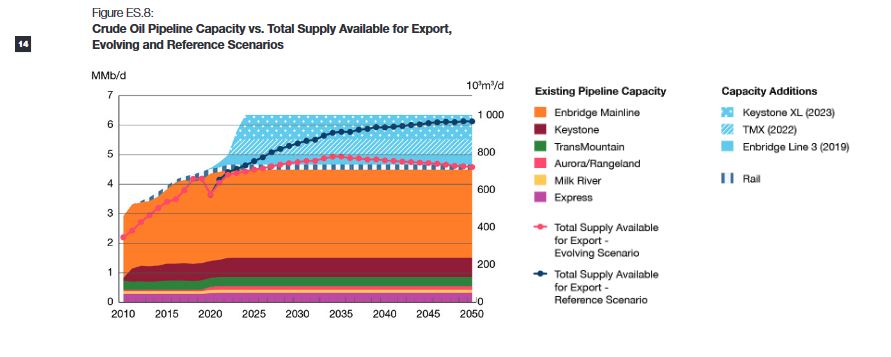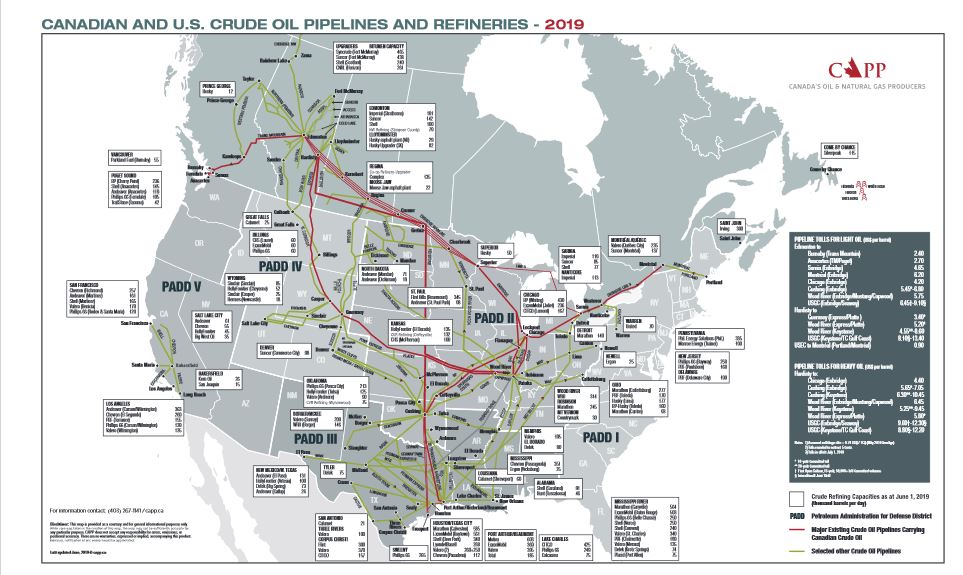This week the Canada Energy Regulator (CER) presented its Canada’s Energy Future 2020 report and almost immediately the contents were misrepresented in the media by activists and pundits alike. In the Globe and Mail Gary Mason stated that “the regulator made one thing abundantly clear: The pipeline era is over.” While Leadnow claimed that the CER says “there is no need for more tar sands pipelines”. Neither of these claims are true, nor are many of the similar claims made by organizations like West Coast Environmental Law, Stand.Earth or Dogwood.
The truth of the matter is that few of these activists have likely read in detail what the CER actually wrote in their report and even fewer will be sharing what the report actually says to their followers. This leaves it to people like me to relate what the analysis in the report means for the viability of the Trans Mountain Pipeline Expansion Project (TMX). As I will detail below, the analysis makes it clear that the TMX remains on solid economic ground.
In the report, the CER presents two basic scenarios:
The Evolving Energy System Scenario (Evolving Scenario) considers the impact of continuing the historical trend of increasing global action on climate change throughout the projection period.
The Reference Energy System Scenario (Reference Scenario) provides an update to what has traditionally been the baseline projection in the Energy Futures series, the Reference Scenario
What the report says is that under the Reference Scenario all the new pipelines in the development queue will be needed. This is shown by the blue line in the graph below. Planned transportation capacity will just be enough to cover planned production capacity, but that includes some pretty big provisos. The biggest is it assumes President-Elect Biden will not follow through on his promise to cancel the permits for Keystone XL. Admittedly election promises aren’t written in stone, but assuming that the new President will ignore an important election promise is not usually a safe bet. It also assumes that a significant amount of production will be carried on rails, something anyone seriously concerned about the environment agrees we want to avoid. But we really aren’t interested in the Reference Scenario at this point, rather what has got the headlines is the Evolving Scenario (the pink line).

As discussed above, it has been widely claimed by the activist community that under the Evolving Scenario the TMX will become a “white elephant” and is no longer economically viable. This is simply not consistent with what the report says nor what is understood about the global market for Alberta heavy oil.
As shown in the graph, under the Evolving Scenario (and in the absence of any new pipeline completions) all the existing transportation capacity will be maxed out by early 2025 with even oil-by-rail being unable to meet the anticipated demand. Put simply, absent some increase in pipeline capacity there will be serious shortfalls in transportation capacity with the ensuing need for some form of curtailment. As we all know a lack of carrying capacity costs the economy and drives down the price Alberta can get for its oil. The graph makes it absolutely clear, even under the Evolving Scenario either Line 3 or the TMX capacity will be needed just to reduce our dependence on oil-by-rail.
Let’s continue with the thought experiment of the Evolving Scenario and no new pipelines. Since transportation capacity will be maxed out, any stoppage on any existing pipeline or any issue with oil-by-rail will result in severe curtailment in a market where Alberta’s production will be needed (see my previous posts about shortages in the world market for heavy oil).
We also have to consider geopolitical considerations. Currently, Canada has no redundancy; almost no control over the pipeline system; and no contingency to deal with breakdowns. In all honesty, right now the Canadian market is dangerously dependent on the Enbridge pipeline system. As we recently discovered, a single state Governor has the potential to hamstring that pipeline system and unravel the Canadian oil transportation network. Moreover, since these decisions are being made outside of our jurisdictions, we don’t even have the power to force action through the courts. Better to have some options should an American politician decide to use Canadian oil as a political hobbyhorse.
Now let’s consider the most likely scenario: both Line 3 and the TMX are completed but KXL is blocked by the US President. What does that mean? Will there be chaos and anarchy? No, it means that the country will have a small amount of surplus capacity; will not need to rely so heavily on oil-by-rail; and won’t need all its infrastructure operating at 100% capacity 100% of the time. As anyone who has made plans knows, it is always better to have a bit of contingency than to be utterly dependent on everything working perfectly all the time. Having both Line 3 and the TMX online provides the ability to deal with ebbs and flows in production and reduces the need for oil-by-rail. That is a good thing.
Another misconception about the CER report comes from the way the graph was designed. As pointed out by Economist Kent Fellows the graph gives a wrong impression, by putting the new pipelines on the top (above the pink line), that Line 3 and the TMX will be the last to get oil if there is more carrying capacity than production. That is simply not what will actually happen. Transportation pipelines will be chosen based on contractual arrangements and which markets they serve. By looking at which markets are served by which pipelines we can establish who will lose their market share first if we end up with excess carry-out capacity. This is where the activists get it particularly wrong about the TMX.
As I describe in my earlier post, the world market is suffering from issues in the supply of heavy oil and the West Coast is severely short on transportation capacity for both heavy and light oil. Let’s look at the current pipeline network.

Where do all the existing pipelines go? Well except for Line 9 (east) and the TMX (west) all the rest go south to the US. So, given a lack of supply which direction would be most likely to be curtailed? Why south of course.
The Trans Mountain is the only player in the game going west. British Columbia, California, Washington, India, China…all can be served by the TMX and can’t be served effectively by any of the other options (except oil-by-rail over the Rockies). Sure you can get to Asia from the Texas Coast, it only takes a trip all the way down North America to the Gulf Coast and then a 10,000 nautical mile trip the long way around the world. This probably explains why 700,000 barrels/day of the 890,000 barrels/day of capacity on the TMX has already been committed. More of that capacity would have been reserved except the CER required that a portion of the capacity be left available for other shippers.
So will the TMX become a “white elephant” that sits empty if the total carrying capacity out of Alberta slightly exceeds Alberta’s production? Absolutely not. Rather, based on legally binding commitments, this pipeline will be at, or close to, capacity from the moment it becomes active. It will be one of the first pipelines filled and one of the last to lose oil.
Contrary to claims by activists, the CER Energy Futures Report does not cast doubt on the economic viability of the TMX nor do CER projections show the TMX is not needed if Canada Acts on climate. As I show above, even when Canada acts on climate the Trans Mountain system will continue to be a shipper of choice and will likely be one of the last pipelines to lose capacity as we migrate off fossil fuels for transportation. It is a strong project with strong financial prospects which probably explains why Indigenous groups are already offering to buy the pipeline even before the construction is complete. I don’t expect they would be doing that if it really was a “white elephant”.
Thanks Blair,
unlikely, but if I -in Europe- would accidentally have been exposed to the CER report, my thoughts might well have me understand Figure ES.8 as the TMX being unnecessary in the evolving scenario, it’s a confusing presentation.
You clarified that this is not the case.
I could live with the evolving scenario as it would lead faster, which may well be necessary, to a zero (?) CO2 emission society, were it not for the lack of world solidarity to pay for this achievement.
In the western world, China and another few select rich countries de-fossilizing may progress at speed, but in the vast number of poor countries this cannot happen, unless the rich nations will pay the cost.
Would the Canadian nation be willing to forego the profits from Canadian resources, which presently pay for many “goodies” in Canadian society, and at the same time be paying additional taxes into this world solidarity fund?
Except for some wild eyed off-grid types, I think not.
Thanks again for the clarification.
LikeLike
As always dead on the mark
Gary Mason of the Globe is a definite” useful idiot”
LikeLiked by 1 person
Gary is anti-Alberta. Always has been, always will be.
LikeLiked by 1 person
Well, you’ve got the “idiot” part, I guess. Gary Mason always wanted to be the next Denny Boyd. Unfortunately, he didn’t have the wit, the writing skill, or the insight – other than that, he was all set. When he finally ran out of chances at the Sun, he blew off to the Globe, so now we get to hear him tell us how Toronto thinks we should think. Lucky us!
LikeLiked by 2 people
Northern Gateway would be up and running by now…..except….
LikeLiked by 2 people
And then, one reads a short sentence in today’s “Oilprice Intel Report”:
“The UAE also said that it plans on spending $122 billion on increasing production capacity.”
LikeLiked by 1 person
Pingback: Understanding what the PBO report says about the Trans Mountain Pipeline Expansion Project | A Chemist in Langley